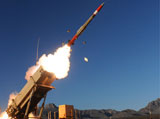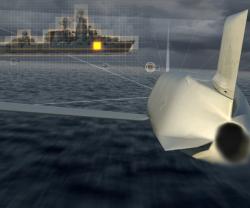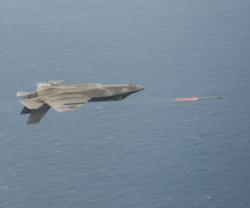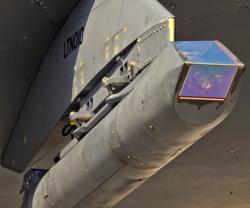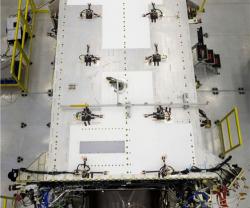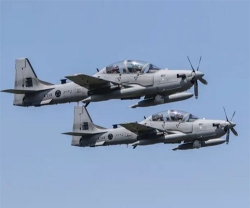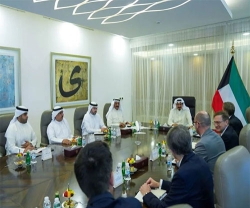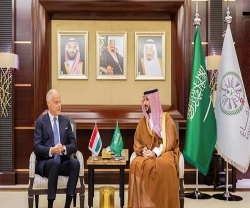Lockheed Conducts Successful PAC-3 Missile Test
03.11.2011 Security
Lockheed Martin's PAC-3 Missile successfully detected, tracked and intercepted an aerodynamic tactical ballistic missile target today in a flight test at White Sands Missile Range, New Mexico.
The test included a ripple fire engagement, utilizing a PAC-3 Cost Reduction Initiative (CRI) Missile as the first interceptor and a PAC-3 Baseline Missile as the second interceptor. The CRI Missile includes block upgrades to the PAC-3 Baseline Missile for performance improvement.
"We continue to improve the capability of the PAC-3 Missile, staying ahead of the evolving threat," said Richard McDaniel, PAC-3 Programs Vice President in Lockheed Martin's Missiles and Fire Control business. "This flight test success completes the validation of PAC-3's latest software and hardware updates as we continue to provide this extremely capable hit-to-kill weapon to the warfighter."
The PAC-3 Missile is one of the world's most advanced, capable and reliable theater air defense missiles. It defeats advanced tactical ballistic and cruise missiles, and fixed- and rotary-wing aircraft.
As the most technologically advanced missile for the PATRIOT air defense system, PAC-3 significantly increases the PATRIOT system's firepower, as 16 PAC-3s can be loaded in place of only 4 legacy PATRIOT PAC-2 missiles on the PATRIOT launcher.
Lockheed Martin achieved the first-ever hit-to-kill intercept in 1984 with the Homing Overlay Experiment, using force of impact alone to destroy a mock warhead outside of the Earth's atmosphere. Further development and testing produced today's PAC-3 Missile, which won a competition in 1993 to become the first hit-to-kill interceptor produced by the U.S. government. The PAC-3 Missile has been the technology pathfinder for today's total conversion to kinetic energy interceptors for all modern missile defense systems.
Lockheed Martin is a world leader in systems integration and the development of air and missile defense systems and technologies, including the first operational hit-to-kill missile. It also has considerable experience in missile design and production, infrared seekers, command and control/battle management, and communications, precision pointing and tracking optics, as well as radar and signal processing. The company makes significant contributions to all major U.S. missile defense systems and participates in several global missile defense partnerships.
The test included a ripple fire engagement, utilizing a PAC-3 Cost Reduction Initiative (CRI) Missile as the first interceptor and a PAC-3 Baseline Missile as the second interceptor. The CRI Missile includes block upgrades to the PAC-3 Baseline Missile for performance improvement.
"We continue to improve the capability of the PAC-3 Missile, staying ahead of the evolving threat," said Richard McDaniel, PAC-3 Programs Vice President in Lockheed Martin's Missiles and Fire Control business. "This flight test success completes the validation of PAC-3's latest software and hardware updates as we continue to provide this extremely capable hit-to-kill weapon to the warfighter."
The PAC-3 Missile is one of the world's most advanced, capable and reliable theater air defense missiles. It defeats advanced tactical ballistic and cruise missiles, and fixed- and rotary-wing aircraft.
As the most technologically advanced missile for the PATRIOT air defense system, PAC-3 significantly increases the PATRIOT system's firepower, as 16 PAC-3s can be loaded in place of only 4 legacy PATRIOT PAC-2 missiles on the PATRIOT launcher.
Lockheed Martin achieved the first-ever hit-to-kill intercept in 1984 with the Homing Overlay Experiment, using force of impact alone to destroy a mock warhead outside of the Earth's atmosphere. Further development and testing produced today's PAC-3 Missile, which won a competition in 1993 to become the first hit-to-kill interceptor produced by the U.S. government. The PAC-3 Missile has been the technology pathfinder for today's total conversion to kinetic energy interceptors for all modern missile defense systems.
Lockheed Martin is a world leader in systems integration and the development of air and missile defense systems and technologies, including the first operational hit-to-kill missile. It also has considerable experience in missile design and production, infrared seekers, command and control/battle management, and communications, precision pointing and tracking optics, as well as radar and signal processing. The company makes significant contributions to all major U.S. missile defense systems and participates in several global missile defense partnerships.
Latest news
Latest events
IDEF 2025 Turkey - International Defence Industry Fair
22 - 27 Jul 2025Istanbul Expo Center - TurkeyDSEI 2025
09 - 12 Sep 2025Excel, London - United KingdomIntersec Saudi Arabia
29 Sep - 01 Oct 2025Riyadh International Exhibition & Convention Centre - Saudi ArabiaDubai International Air Chiefs’ Conference (DIACC 2025)
16 Nov 2025Atlantis, The Palm Dubai - United Arab Emirates

